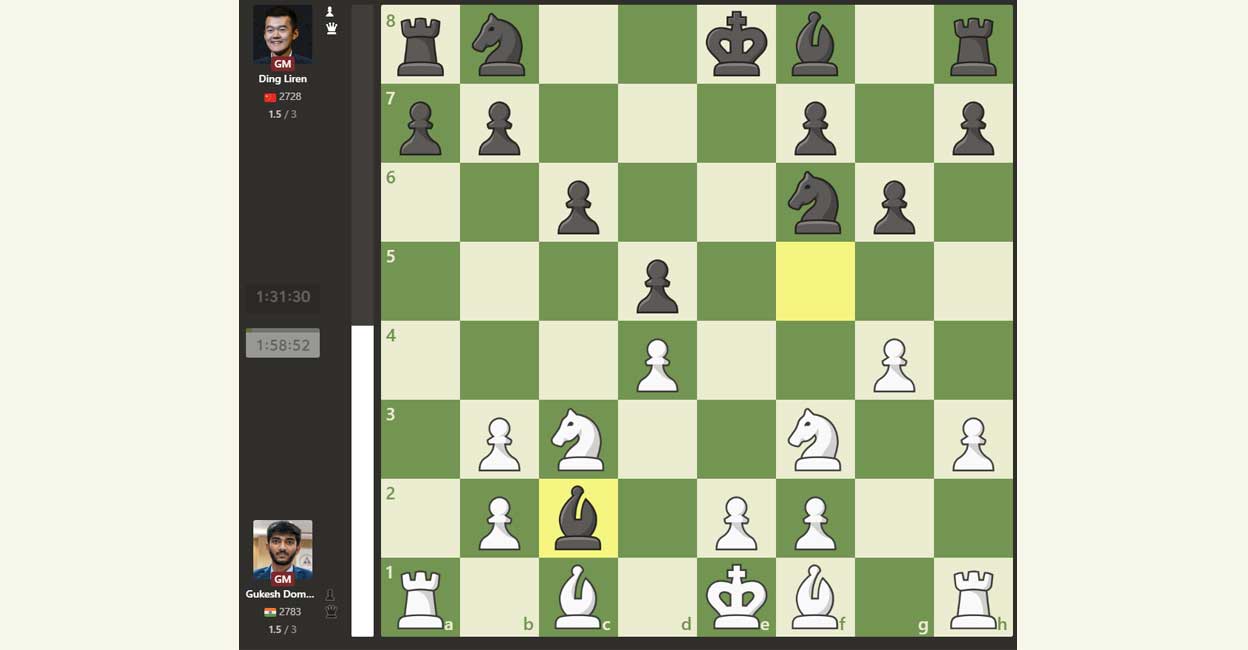Gukesh wins Game 3 after Ding's 'Abhimanyu' bishop falls in labyrinth of time

Mail This Article
It is not clear how well-versed world champion Ding Liren is in 'Mahabharata'. But if the Chinese GM needed a crash course in the Hindu epic, young Indian challenger D Gukesh offered him one in Game 3 of the World Chess Championship match in Singapore on Wednesday.
Gukesh vanquished the reigning champion to level the title clash at 1.5 points each. The 18-year-old Gukesh, who had lost Game 1 with white and drew the next with black, got his first win of the 14-game match, again with white pieces.
On move 10, just after the queens were exchanged, Ding made a daring move, Bc2. He had slingshot a bishop across the board and planted it in safe zone between Gukesh's King and a rook. (Check out Game 3)
A lone bishop, so full of potential, entering an enemy territory. What could possibly go wrong? That is probably what the young 'Mahabharata' warrior 'Abhimanyu' thought when he entered the 'Chakravyuha', a mythical military formation resembling a labyrinth of defences.

Just like Arjuna's ambitious son Abhimanyu, who knew how to penetrate the 'Chakravyuha' but not how to exit, Ding's daring bishop was trapped and died on the same c2 square 14 moves later. By capturing Ding's cornered bishop, Gukesh gained a material advantage that proved decisive.
Ding seemed restless for the first time in the match and repeatedly glanced across the board. But Gukesh sat like a monk, eyes shut, in a state of meditation. The first time he took a quick look off the board was after playing Nd2 on move 14, a knight move that essentially trapped that 'Abhimanyu' bishop.
Ding spent a great deal of the two hours at his disposal trying to figure out how to save the bishop. The 32-year-old thought hard for more than an hour to make his first 13 moves. Meanwhile, Gukesh made his first ten moves in less than four minutes. The young Indian, who had come under time pressure in the first game, was too quick with his calculations in this game.
According to the time control FIDE had set for this world championship match, both players are given 120 minutes each to make their first 40 moves. A player whose time ends is declared lost. But to prolong the game, the players must reach move 41, giving them 30 more minutes each, with a 30-second increment per move.
The precious time Ding used up in defence of his bishop proved costly as he was left with less than 20 seconds to make six critical moves before the game slugged to move 40. Gukesh on the other hand had more than 10 minutes on his clock.
Eventually, after 37 moves, Ding was trapped in the labyrinth of time as his clock stopped, and Gukesh was declared the winner. Gukesh had been sharp with his moves. Midway into the game, the evaluation bar placed a 70% win probability for Gukesh. The open-source chess engine Stockfish 16.1 placed Gukesh's move accuracy at 96.4%, while Ding's hovered under 90%.
While onlookers have the luxury of analysing games using supercomputers, the players must simply stare at the wooden pieces scattered across 64 squares and be human. "A chess game is essentially a struggle between two humans," said former world champion Viswanathan Anand as he analysed the game midway through with FIDE commentators GM David Howell and IM Jovanka Houska. Both players struggled, but it was Ding who came out wounded. Game 4 of the match will be played on Friday after a day of rest.

